Features
Defeating River Blindness
| USF News
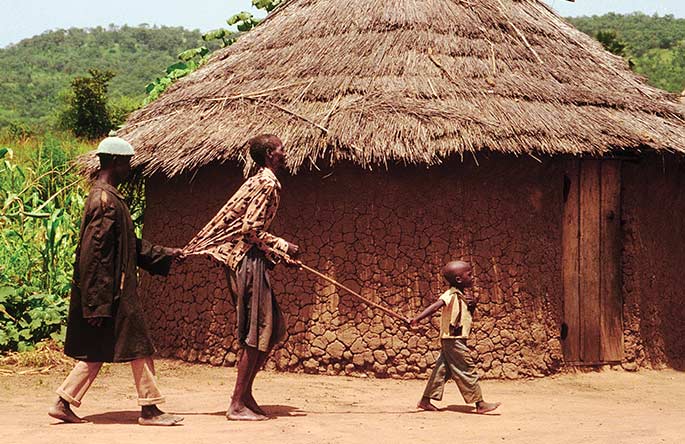
Photo by Bill Vanderdecker | Merck & Co., Inc.
Tom Unnasch sat in the Land Rover, bouncing over the deeply rutted dirt road leading to a little village of mud huts and maybe 200 people in the south of Ivory Coast, Africa.
As he stepped out of the vehicle, small children came running to see the stranger in their village. The youngsters wore tattered clothes. Food was scarce. What he saw, as he looked deeper into the community along the Bandama River, was palpable.
A small child, holding a long stick, was leading a blind man clutching the other end of the stick through the dusty paths between the huts. In another area, he saw more blind adults, unattended, stumbling about.

Photo by K. Hinton | The Carter Center
The older men and women suffered from onchocerciasis, or “river blindness,” a parasitic disease transmitted to humans through the bites of black flies.
The scene Unnasch witnessed in 1992 is repeated in countless other villages throughout sub-Saharan Africa, where at the time an estimated 60 percent of the adult population in rural areas, especially in areas close to rivers, was blind. It’s a scene that has been constant for generations.
Thirty-eight million people are at risk. In Ivory Coast. Mali. Sierra Leone. Senegal. Democratic Republic of Congo, among others.
The affliction strikes youngsters just a few years old and incubates over years. Eventually it causes severe itching and inflamed tissues. Once it reaches the interior chamber of the eye — which can take 10 years or longer — scarring occurs that results in incurable blindness. The communities hardest hit just dissolve, the social structure crumbling from the debilitating impact of the disease on the population, both young and old.
“When I saw this, I said ‘Oh my God, we’ve got to do something,’” recalls Unnasch, a professor in USF’s College of Public Health.
“It was a life-changing experience for me.”
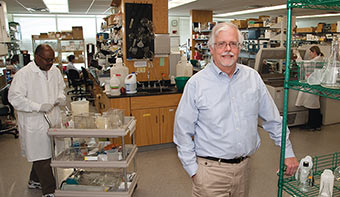
Thomas Unnasch in his lab on the Tampa campus, where graduate students are involved in several research projects.
Photo by Aimee Blodgett | USF News
Thomas Unnasch always wanted to do something “to make a difference to help people.” After graduating from Rutgers University in his native New Jersey, he went on to graduate studies at MIT and Harvard. During postdoc work in Boston in 1985, he began to zero in on river blindness, conducting molecular analysis of the disease and how it attacks the body and looking at proteins that could be used to develop a vaccine.
Throughout his career, which included time at Case Western University and 19 years at the University of Alabama-Birmingham, Unnasch continued his research on molecular epidemiology in vector-borne diseases. Translated, this means he studies disease in people and animals caused by blood-sucking insects.
In 2007 Unnasch came to USF where he is currently chair of the Department of Global Health in the College of Public Health. The projects he’s involved with focus on health problems that affect the global population — intestinal ailments, malaria, West Nile Virus, Eastern Equine Encephalitis and emerging and infectious diseases.
During his research on river blindness — which has taken him to Central America, South America and Africa — Unnasch has worked closely with the Carter Center, from which he has received funding, along with the National Institutes of Health and the Gates Foundation.
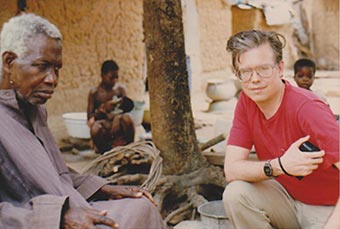
Unnasch at an African village in the 1990s.
Photo courtesy of Thomas Unnasch
He made his first trip to Africa in 1992 to set up a research lab in Bouake, Ivory Coast to study the disease and its transmission. It’s when he made the journey south to the village along the Bandama River to witness the impact of the disease firsthand. River blindness strikes hardest in communities close to fast-moving rivers, where the black flies breed.
The infecting cycle is vicious and effective.
When the flies bite humans, infected larvae pass from the fly into the human. The larvae, over time, mature into worms and cluster under the skin. Male worms move from colony to colony to mate with the females, which produce eggs that develop into larvae, called microfilaria. Thousands of microfilaria are produced daily inside the body.
If another fly bites an infected human, the microfilaria are transferred to the fly, which eventually will bite another human and infect that person. And on it goes.
The microfilaria migrate throughout the body and cluster. Areas of the skin can be so densely infected with microfilaria that 40 percent of the skin by weight is parasite.
When the microfilaria die under the skin of the host, it causes severe itching, lesions and swelling. If the microfilaria enter the eyes, lesions and scarring leave the corneas opaque, resulting in blindness. To reach this stage takes years.
If a child is infected when he is 3 or 4, Unnasch says, he’ll go blind in his teens. A blind 15-year-old, in the prime of his life, can’t farm the land, can’t contribute to the sustainability of the village. Multiplied over and over again, the village just collapses.
But there is hope.
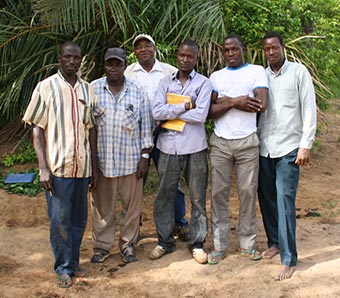
Unnasch has been involved in setting up seven research labs in Central and South America and Africa. Lab workers in Africa collect black flies to research the transmission of the disease, onchocerciasis.
Photo courtesy of Thomas Unnasch
Back in the early 1990s, river blindness not only impacted sub-Saharan Africa, but it was found in 12 regions in Central America and the northern part of South America. Then came the development of the drug ivermectin to fight the disease, which was approved for human use in 1995.
It was widely distributed to indigenous populations at risk, and now river blindness has been eliminated in 11 of the 12 regions in Central and South America, Unnasch says. Just pockets of population are still battling the disease, but more than 99 percent of the people at risk are now free of the disease.
To conquer the disease, Unnasch says, the population needs to take ivermectin pills twice a year for 10 years. Ivermectin kills the larvae, or microfilaria, that cause the severe itching, swelling and reach the eyes. But the female worms that produce the larvae continue to live under the host’s skin. The worms have a life cycle of 10 years, so treatment needs to continue until the worms die.
Once all the hosts are free of the microfilaria and worms, the disease is eradicated in the community. The black flies no longer transfer infected larvae.
The drug company Merck has donated millions of doses of ivermectin under the brand name Mectizan to combat onchocerciasis, and the company is committed to the donation program until the disease is eradicated worldwide.
The fight continues, Unnasch says, but it’s more difficult in Africa, where remote villages are hard to reach, and treatment to the entire population is challenging.
“Getting the drugs out to where they need to go is daunting,” he says.
Unnasch returns to Africa once or twice a year, and is heading back there in August. The lab he helped start in the Ivory Coast in 1992 was relocated to Burkina Faso in 2000. He has helped establish other labs in Africa — in Nigeria, Uganda and Sudan — and several others in Mexico, Ecuador, Guatemala and Brazil.
Unnasch was not involved in the development of ivermectin, and the distribution of the drug is handled by the individual communities.
The labs Unnasch helped establish continue to monitor the transmission of onchocerciasis and work to develop better monitoring tools and collecting traps. They also develop remote sensing models to predict the disease locations.
If the transmission cycle is broken, scientists know progress is being made in eradicating the disease. One village at a time. One region at a time. Central and South America have had great success. Last year, Uganda reported the disease transmission cycle broken in several areas of the country.
“A tremendous amount of progress has been made in the past 20 years,” Unnasch says.
“We’ve got this thing on the run.”
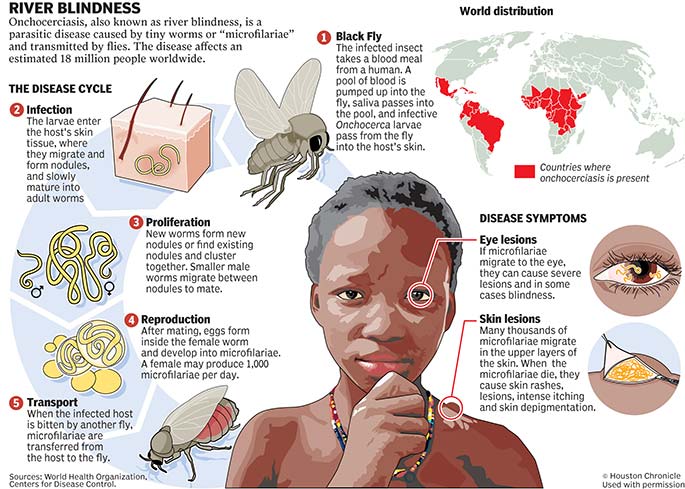
The graphic above shows the cycle of onchocerciasis, or river blindness, one of the major causes of blindness in the world.
© Houston Chronicle. Used with permission